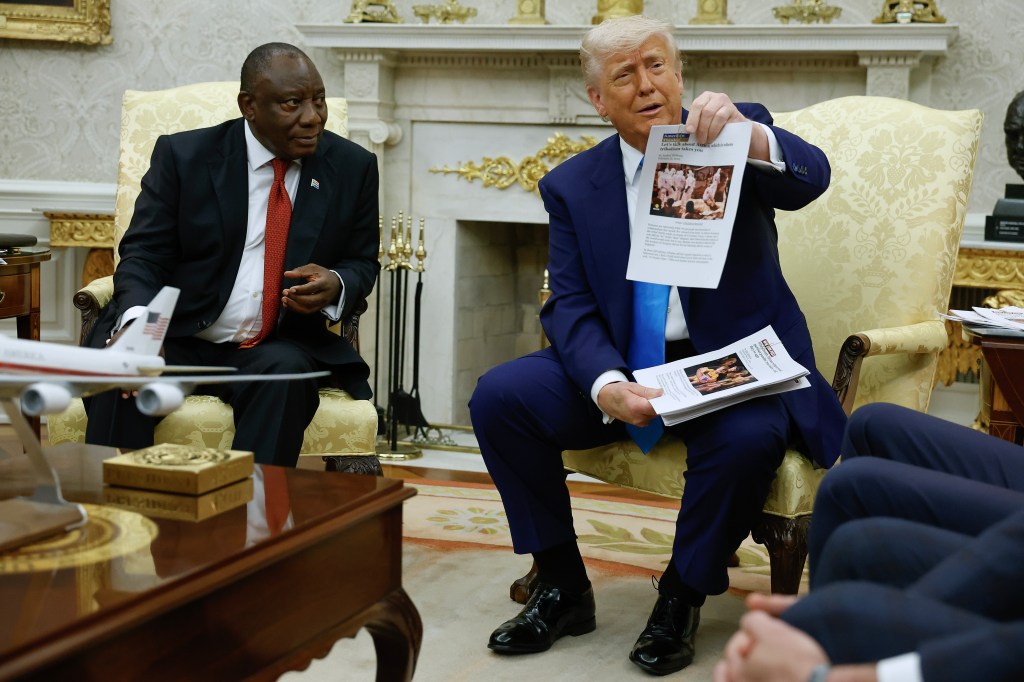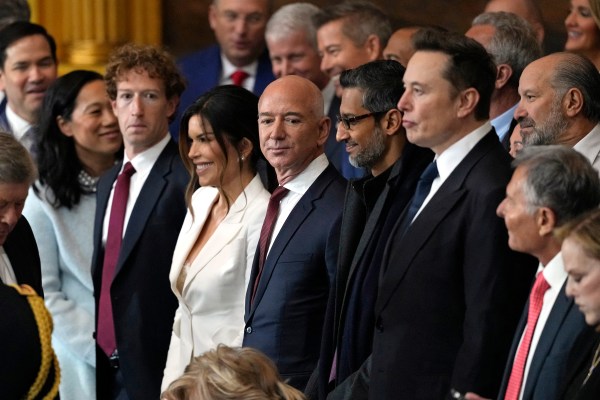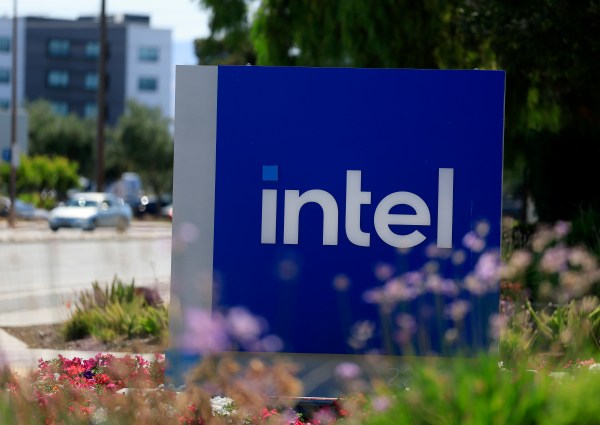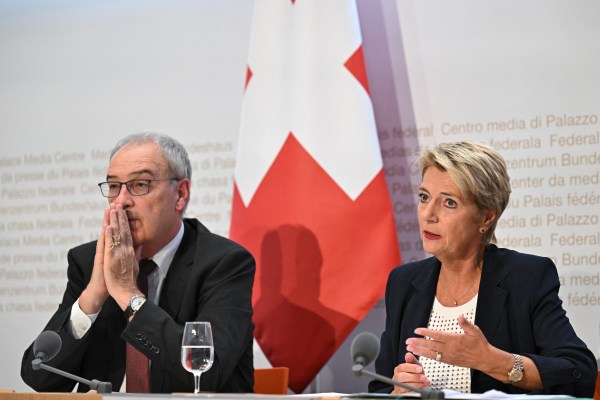Forget standing upon a bully pulpit. President Donald Trump prefers to humiliate other leaders seated, in the Oval Office, before TV cameras. Consider the scene that unfolded this week with the visit of South African President Cyril Ramaphosa.
The White House press pool squeezed into the crowded Oval Wednesday as Trump and his counterpart exchanged pleasantries. The leaders were flanked on the couches by their respective government delegations. Trump pointed out the presence of two of South Africa’s legendary golfers, Ernie Els and Retief Goosen, as Ramaphosa smiled, perhaps relieved that his gambit to appeal to the golf- and celebrity-attuned American president had worked. Unfortunately it had not, as Ramaphosa found out a few moments later, when members of the media began asking questions and the mood in the room shifted.
A reporter shouted out a question directed at Trump: “What will it take for you to be convinced that there’s no white genocide in South Africa?” Ramphosa politely cut in to answer, clearly prepared to defend his government from the accusations Trump had recently made that a “genocide” targeting white Afrikaner farmers was taking place in South Africa. Trump grinned and yielded.
“It will take President Trump listening to the voices of South Africans, some of whom are his good friends, like those who are here,” Ramaphosa said, gesturing toward Els, Goosen, and a third white South African, his agriculture minister. “If there was Afrikaner farmer genocide, I can bet you these three gentlemen would not be here.”
But Trump wasn’t ready to listen, instead directing Ramaphosa’s attention to a large TV screen along the wall of the Oval Office, on which a compilation video began playing. “Turn the lights down,” Trump said as Ramaphosa’s eyes widened and he briefly tried to speak up. Trump pointed back toward the screen, and the discomfited Ramaphosa turned his body around to watch.
The four-and-a-half-minute video was a sensational compilation of clips purporting to be proof of Trump’s claims of widespread land confiscation and murders of white farmers (which the administration has used to justify granting refugee status to scores of Afrikaners coming to the United States). There were speeches in South Africa’s parliament about removing white farmers, chants at political rallies about shooting white farmers, and an aerial shot of a country road lined with crosses to symbolize white farmers who have been killed.
When the video ended, Trump then leafed through several printed news articles about recent murders of white farmers in South Africa, showing them off to the camera before eventually taking the entire pile and handing them to Ramaphosa.
The South African president, looking shellshocked and embarrassed to have this playing out in front of the media, tried to “clarify,” as he put it, some facts about what is happening in his country. The political leaders and rallygoers, he noted, represent an extremist minority party, there is no government policy to violently seize land from Afrikaners, and he would appreciate the United States’ help in getting his country’s very real crime problem under control. Trump stuck to his guns, repeating that it was a problem that needed to be addressed, and the two leaders, in front of the media at least, sat at an impasse on the issue.
(Ramaphosa’s defense mostly aligns with the facts of South Africa’s land reforms, and while there are plenty of questions about the justness of the country’s expropriation laws, there’s no evidence that the government is behind or encouraging violent crime against white farmers or the unlawful seizure of their land.)
But the long, uncomfortable drama of Wednesday’s meeting is only the latest example of how Trump has used stagecraft and the backdrop of the White House to put political and geopolitical foes on the spot in front of an audience.
In his first term, there was the awkward clash he had with Democratic congressional leaders over government funding. Sen. Chuck Schumer and Rep. Nancy Pelosi were there to negotiate keeping the government open weeks after their party had won majorities in the 2018 midterm elections. But in front of the press pool, Trump threw the leaders off by criticizing their opposition to building a border wall. The president had turned what might have been a cordial public photo-op before the real negotiating happened behind closed doors into a chaotic back-and-forth that soured things within the newly divided government almost immediately.
“I don’t think we should have a debate in front of the press on this,” Pelosi said at one point during the meeting.
And earlier this year, the infamous sit-down with Ukrainian President Volodymyr Zelensky featured a tag team between Trump and his vice president, J.D. Vance. The war-weary president of Ukraine seemed caught off guard by the hostility from Vance, and his attempt to set the record straight on Russia’s repeated violations of ceasefire agreements sent the meeting into a tailspin. At one point, Trump accused Zelensky of “gambling with World War III” and chastised the Ukrainian for daring to suggest America might regret not helping win the war against Russia.
What’s remarkable isn’t that Trump is engaged in tense and heated conversations with other leaders but that it so often happens out in the open. Trump’s adversaries in these meetings realize too late that the American president has set up a performance in which they also have a role to play: the punching bag, the sucker, the one who is trying to pull one over on Trump and the United States but has been caught in the act.
But here’s what else is notable: Trump’s choice of victim for the embarrassing Oval Office public takedown is never a major power like Vladimir Putin of Russia or Xi Jinping of China. Instead, Trump prefers to make an example out of the imperfect, emerging players like South Africa or Ukraine, flexing his muscles while standing over leaders that must try their best to make nice with a bully.









Please note that we at The Dispatch hold ourselves, our work, and our commenters to a higher standard than other places on the internet. We welcome comments that foster genuine debate or discussion—including comments critical of us or our work—but responses that include ad hominem attacks on fellow Dispatch members or are intended to stoke fear and anger may be moderated.
With your membership, you only have the ability to comment on The Morning Dispatch articles. Consider upgrading to join the conversation everywhere.